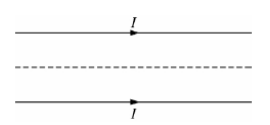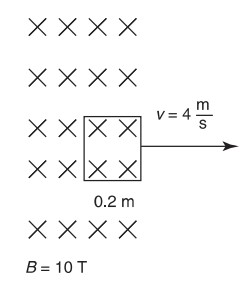Question

Two long, straight, parallel wires in the plane of the page carry equal currents I in the same direction, as shown above. Which of the following correctly describes the forces acting on the wires and the resultant magnetic field at points along the dotted line midway between the wires?
Forces Field
(A) Attractive Not zero
(B) Attractive Zero
(C) Repulsive Not zero
(D) Repulsive Zero
▶️Answer/Explanation
Ans:B
Solution: Wires with current in the same direction are attractive. Using RHRcurl for each wire at the location shown has the top wire having Bin and the bottom wire making Bout. Since its at the midpoint the fields are equal and cancel to zero.
Question
An electron (charge e , mass m ) is trapped in a circular path because of a uniform perpendicular magnetic field B . The velocity of the electron is v , and the radius of the path is r . Which of the following expressions represents the angular velocity ω ?
(A) \((Ber/m)^{1/2}\)
(B) \((Be/rm)^{1/2}\)
(C) \(Be/m\)
(D) \(2\pi Be/m\)
▶️Answer/Explanation
Ans:
(C)
Magnetic force causing centripetal acceleration:
\(evB=mv^{2}/r\)
Solve for v : \(v=eBr/m\)
This tangential v is equal to ωr : \(\omega =v/r=(eB/m)\)
QUESTIONS (a) AND (b) ARE BASED ON THE FOLLOWING INFORMATION AND DIAGRAM:

A square wire frame is pulled to the right with a velocity of 4 meters per second across and out of an inward uniform magnetic field of strength 10 teslas. The length of each side of the frame is 0.2 meter.
Question(a)
What is the magnitude of the induced motional electromotive force in the wire as it leaves the field?
(A) 40 V
(B) 20 V
(C) 8 V
(D) 16 V
▶️Answer/Explanation
Ans:(C)
emf = Blv = (10)(0.2)(4) = 8 V
Question(b)
As the wire is moved to the right, a force appears to oppose it. This force’s opposing direction is best explained by
(A) Lenz’s law because an opposing force keeps the flux from changing
(B) Faraday’s law because the changing flux induces emf
(C) Lenz’s law because the force must be in the negative direction
(D) Faraday’s law since decreasing flux always produces negative forces
▶️Answer/Explanation
Ans:(A)
Lenz’s law states that the induced emf always opposes the change in flux. Since the flux is decreasing, the current induced will be clockwise to add to the existing field. The upward current on the left-hand side of the loop will create a force to the left.
Question
Which of the following correctly describes the magnetic field near a long, straight wire?
(A) The field consists of straight lines perpendicular to the wire.
(B) The field consists of straight lines parallel to the wire.
(C) The field consists of radial lines originating from the wire.
(D) The field consists of concentric circles centered on the wire.
▶️Answer/Explanation
Ans:(D)
Magnetic field lines loop around the moving charges.
